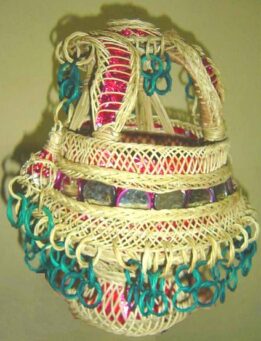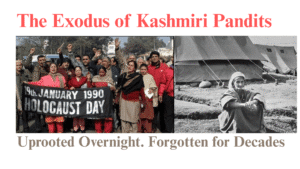Imagine the magic of Kashmir – snow-capped peaks glistening, warm fire crackling, and the aroma of Kahwa and Ksheer chai ( Noon Chai) swirling in the crisp mountain air. But amidst these wonders, there’s a simpler magic, a symbol of Kashmir’s soul – the Kangri.

The Kangri is an earthen pot, a beacon of hope in harsh winters. It’s not about grandeur, but the quiet comfort of everyday moments. This simple pot, nestled under a cosy Pheran and Ptchoch becomes a shield against the biting cold.
Isbandh Burning in Kangri- Burning Negativity
For generations, the Kangri has warmed not just bodies, but also spirits. In Kashmiri weddings, with the Isbandh burning, burning negativity, it transcends warmth to symbolise prosperity and blessings for the wedding couple. The smoke, fragrant and hopeful, carries centuries of tradition, sealing their union with the promise of a warm and joyful future together.
Kangri : A Bond Woven in Twigs
The Kangri is more than clay and embers. It’s a labour of love. Willow twigs, woven into intricate baskets, become a warm embrace. Each Kangri is unique, a reflection of the artisan’s heart.
Kangri : The burning companion
Yes, the Kangri’s warmth can sometimes turn into a flicker of danger. Yet, the love Kashmiris have for this companion remains strong. It’s a reminder to respect its power, a bond forged in respect and tradition.
The Kangri Song
Ember-cradled in fired clay, the Kangri glows,
A hearth’s smouldering heart ‘gainst winter’s snows.
Its wispy smoke unfurls on frigid breath,
Revival’s sweet incense, defying death.
Beneath thick pherans, snug against the cold,
This earthy mate’s embrace does bodies enfold.
Its warmth, a solace from the Valley’s bitter chill,
Pulsing life’s cadence through each frostbit hill.
A humble vessel, yet replete with grace,
The Kangri’s ardent blaze illumes each face.
Rosy cheeks betraying inner smiles wide,
As memories kindled blaze in cherished pride.
More than just warmth beneath those woven folds,
A living tie to tradition’s grasp it holds.
The Kangri’s glow, a beacon ‘across the ages,
Burning bright upon Kashmir’s cultured pages.
The Kangri is a reminder that true beauty lies not in grandeur or opulence, but in the quiet, unassuming simplicity of everyday moments. It’s a celebration of the beauty of the mundane, of the way a simple earthenware pot can become a beacon of hope and comfort in the darkest of winters. It’s a testament to the power of tradition and heritage to bring people together, to create a sense of shared identity and purpose.
Components of Kangri
Willow twigs (Kani): The primary raw material is willow twigs, which are harvested from willow trees or cultivated in nurseries. The twigs are usually harvested twice a year, in autumn and spring.
Earthenware pot (Kundal): An earthenware pot, called a Kundal in the local parlance, forms the base of the Kangri. The pot is made by potters and then sold to craftsmen who decorate them with twig baskets.
Charcoal ( Tchani): The Kangri is filled with burning charcoal to provide heat. In Kashmir, we Called it Tchani. Smouldering Charcoal into embers ( TChani into Tengel)
Decorative materials: The woven twig baskets are often adorned with colourful threads, mirror work, and sequins for decoration
TChalan: A Tchalan is a Tool made of Wood or iron used to intensify the burning by turning the ashes ( Soor) upside.
FAQs on Kangri
What is a Kangri?
A Kangri, also known as Kanger or Kangid, is an earthenware pot filled with glowing embers and covered with handmade wicker baskets.
How is a Kangri used?
The Kangri is used as a portable source of heat by carrying it close to the body under clothing, especially during the harsh winters in Kashmir.
What materials are used to make a Kangri?
A Kangri is typically made from clay, willow twigs, and wickerwork, with the clay pot forming the base and the wicker providing insulation and protection from direct heat.
What is the cultural significance of the Kangri?
The Kangri symbolizes warmth, comfort, and resilience in Kashmiri culture, playing a crucial role in the lives of Kashmiris, especially during cold winters.
Are there any health risks associated with using a Kangri?
While the Kangri is a traditional and effective source of heat, there are health risks associated with its use, leading many urbanites to opt for modern heating methods like electric heaters.
Is the Kangri used in any specific ceremonies or events?
Yes, the Kangri holds ceremonial importance in events like marriages, symbolizing prosperity and well-being for the newlyweds in Kashmiri culture.




